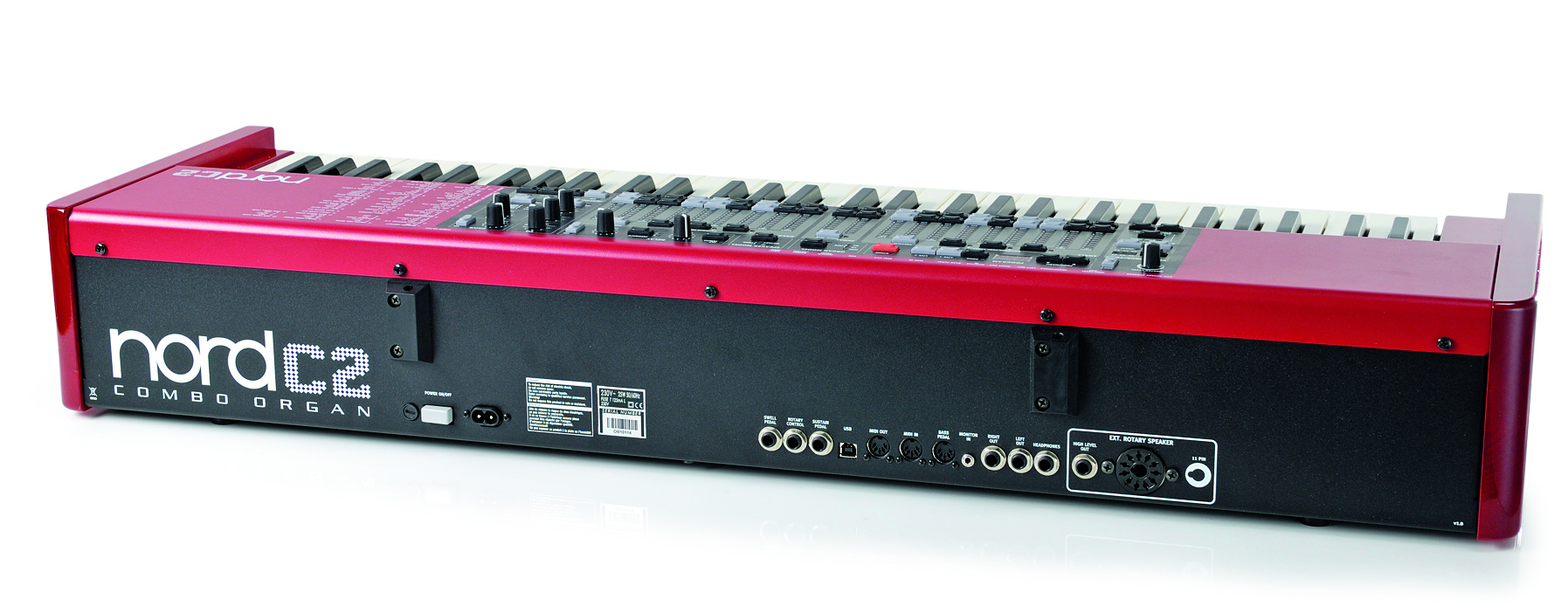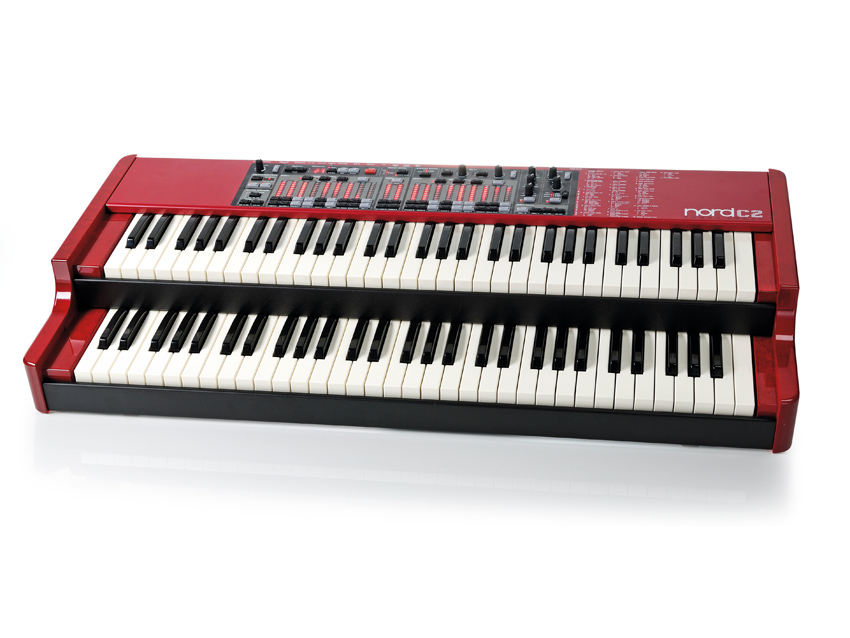MusicRadar Verdict
The C2 is hard to beat. It looks and feels great and delivers authentic emulations across the board.
Pros
- +
Very portable and well built. A doddle to use. Every emulation sounds very authentic and it's a joy to play.
Cons
- -
The C1's Unison mode has been removed. Sub menu feature labelling could be on a peel-off sticker.
MusicRadar's got your back
The C1 Organ was Nord's first dedicated two manual Hammond B3/Vox/Farfisa emulator and it's fair to say that Clavia got it pretty much spot on first time round. However, the C2 promises to improve on an already winning formula that has many fans.
The C1 is considered pretty authentic and quickly established itself with the very hard to please Hammond emulator community. So what's new and improved this time around? At first glance you would think not much has changed but there are numerous improvements both under the hood and cosmetically.
What's new?
First up, the percussion controls have been moved much nearer the manuals, which is very welcome, and now have additional coupler modes in the new pipe organ mode. The vibrato/chorus (and now tremulant) controls have also been moved to a more easy to reach position and the vibrato/chorus manual selectors have been moved from the drawbar area to a much better place with the rest of the vibrato/chorus controls.
One thing missing is the old C1 Unison Mode (this was a kind of three mode stereo chorus); not a big deal for us, but still worth mentioning. Also, the rotary speaker controls now double as couplers in the pipe organ mode, allowing one manual's stops to be played by the other, coupling of the lowest bass note to the super low bass stop for massive rumbling bass, plus further coupling of both manual's stops to the pedals and more (there are seven coupler modes for maximum flexibility).
"All in all, the C2 is much more logically laid out and quicker to use on the fly than the C1 which is a real bonus."
While on this topic, we should say that there's been a slight renaming of the break control from 'break' to 'stop' (used to stop the rotary speaker spinning). Pipe organ stop names have now been added under the drawbars, too, and preset space has been increased from 100 to 126 slots to accommodate the extra pipe organ programs, so there's plenty of scope for creating plenty of your own sounds.
Our review model arrived with the front mounted rotary speaker flick switch (an extra cost option), which works great and goes in the same position as on a real B3 to preserve the authentic feel. This connects to the rear panel via a jack and screws into the front underside of the C2.
All in all, the C2 is much more logically laid out and quicker to use on the fly than the C1 which is a real bonus. All the easy to access sub menu features are listed in full on the front panel too, which is handy, though we wish this was a peel off sticker as it does detract from what is a beautifully put together and great looking instrument.
Want all the hottest music and gear news, reviews, deals, features and more, direct to your inbox? Sign up here.
One of the most endearing features of the C1 organ was its lightweight form factor and the C2 thankfully retains this lightness too, being only one pound heavier than its predecessor. It's very easy for one person to pick up which is great for such as large instrument and it certainly beats dragging a real Hammond around!
The action of the manuals is pretty much the same as the Nord Electro 3 and is great for organ playing. It's slightly stiffer than a real Hammond but still a joy to play, and it's possible to set the organ to play with a very quick trigger point for super fast playing.
Keyboard click can be altered to taste, too, and most other sections have further tweakable parameters in the sub menu system. It's easy to change percussion volume, decay, rotary speaker horn and bass rotor speed and acceleration, plus there are three tonewheel modes that allow you to turn your C2 into a beaten up sounding or brand new sounding organ as you wish. There's also the possibility to cancel the ninth drawbar when percussion is engaged as on real Hammond - very authentic.
Sounds
So what of the sounds? Well the new pipe organs are superb and, coupled with the onboard reverbs, really transport you into the grand surroundings of cathedrals, churches and concert halls. The samples are excellent, the tremulants are authentic and it's incredibly easy to use. We can see many a church organist and new players alike having fun with this instrument, but it also works brilliantly in a recording context.
Same goes for the B3s, Voxs and Farfisas - they are all superb. We really can't find fault with any of the emulations - they are authentic throughout and very inspiring to play. In comparison with our 1958 Hammond B3 and 122 Leslie, the C2 really does capture the mojo and overall tone/feel.

Effects and more
The onboard amp models (Roland Jazz Chorus and Fender Twin) work well and are great for that un-Leslie'd straighter rock sound, while the drive control sounds rich, and full, allowing some real power-organ playing or subtle grit.
The delay, three-band EQ and five reverb modes are musical, high quality and flexible, bringing realistic and natural sounding acoustical support to all the sounds. In particular, the delay is great for reggae or dub, especially along with the tap tempo function.
One of our favourite additional features is the ability to add a set of MIDI bass pedals to control the pedal manual. Further to this, the Synth Bass mode adds a synth bass sound to further beef up the low end. Perhaps in the future, Clavia could augment this feature with some different synth tones, plus the ability to turn the full lower manual into a synth bass.
To conclude, as far as B3/Vox/ Farfisa/Pipe Organ emulators go this board cannot be beaten in terms of sounds, playability and portability. Put it at the top of your list immediately!
Listen to the Nord C2 in action:
B3 rotary
B3 soft drive
Farfisa
Vox drive
Pipe organ
-------------------------------------------------------------------------------------------------------------------
Liked this? Now read: The 11 best DAW software apps and The best hardware synths available today
Future Music is the number one magazine for today's producers. Packed with technique and technology we'll help you make great new music. All-access artist interviews, in-depth gear reviews, essential production tutorials and much more. Every marvellous monthly edition features reliable reviews of the latest and greatest hardware and software technology and techniques, unparalleled advice, in-depth interviews, sensational free samples and so much more to improve the experience and outcome of your music-making.

